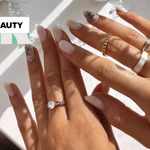You can learn to tame the tresses on your head, but facial hair often refuses to play fair. It seems to sprout out of nowhere right when you think you have things under control. Chin hairs, mustaches, and sneaky side burns cause many women to start running for the closest razor they can find. But, if you’re not careful, that hair you shaved last week might return with a few more unwanted peach fuzzy friends. Due to hormonal changes or heredity, many women experience facial hair. But, it’s important to note that your body is your choice - there’s no shame in having or not having body hair of any kind. If you’re looking to remove facial hair, the key is to safely remove it without causing unwanted issues.
What Causes Facial Hair?
Facial hair for women is not uncommon. The two leading causes are genetics or hormones. If women in your family have facial hair, it will explain why you have it too. Another reason for facial hair could be a change in hormones. Hormones make a shift at different stages of life like puberty, pre-menopause or after menopause. Other times women may also see an increase in facial hair before or after pregnancy. Excessive facial hair can also be a sign of something more serious, so women should see a doctor to be sure they don’t have a medical condition.
What Are the Safest Ways to Remove it?
There are several ways to remove facial hair. Shaving may be the fastest, but it can also lead to ingrown hairs. Shaving can also cause cuts and lead to infection. If you have very little facial hair, using a natural scrub of lemon and sugar can provide good results. Mix into a sticky paste with very little water and apply. The sugar granules will help remove the hair and the lemon juice has a bleaching effect. This can be done every other day. A similar paste can be made using oatmeal and banana. Apply the paste and massage in the opposite direction of its natural growth pattern to pull hair from the root and away from the skin.
A Skin Specialist’s Top 4 Approaches for Removing Facial Hair
Sharee Sargent, Master Esthetician and skin specialist from Spa Tech in Massachusetts offers a few cosmetic ways to help you put your best face forward.
- Hard Wax: “It doesn't adhere to the skin and is perfect for thick hair.”
- Laser Hair Removal: “Faster and semi permanent.”
- Tweezing: “It lasts for about 3 weeks, more precise, but time consuming.”
- Threading: Great for hair on the cheeks “but go to an experienced threader with at least 2-5 years experience.”
Prevention
The best way to fight back on facial hair is prevention. Since one cause of hair growth is hormonal imbalance, adding a few things to your diet may keep those unwanted hairs at bay.
- Spearmint Tea: Studies show that drinking two cups of spearmint tea helps to reduce testosterone, which is linked to why some women have an increase in facial hair.
- Maca Root: Is a plant known as a superfood. This natural supplement is usually ground and sold in a powder form, but you can also buy capsules or find it in a liquid. Maca root is known to balance hormones and is even prescribed to those who manage excessive facial hair.
- Vitamin Supplements: B6 works to decrease the release of testosterone in the body. Vitamin E supplements are known to be great for the skin, but it also regulates hormones in the body. Magnesium, zinc, and copper can also work to decrease the effects of testosterone and decrease the chances of unwanted facial hair.
Keep Your Head Up
For many, fighting facial hair is a daily battle. If this is you, don’t stress. Having a few whiskers or a fuzzy face is not the worst thing that can happen, and having facial hair will never make you “less” of a woman. You can decide to remove it, or let go of what society expects and lean into the changes happening to your body. Tweeze for special occasions and photoshoots - or not at all. What is deemed truly beautiful comes down to mindset, not genetics, hormones, or anything external. But, if you do decide to make facial hair a thing of the past, choose a safe route and keep it moving.







